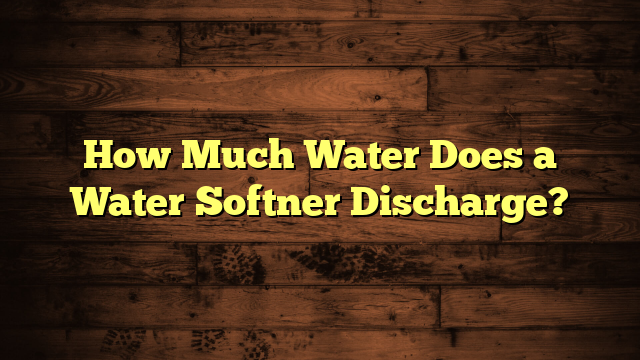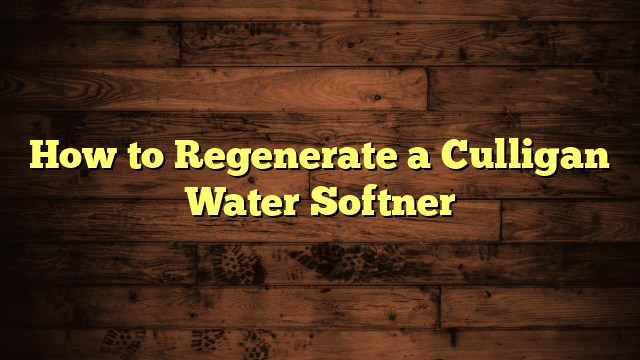How Much Water Does a Water Softner Discharge?
When considering a water softener for your home, you might wonder just how much water it discharges during its regeneration process. Typically, you can expect anywhere from 50 to 100 gallons, but this amount can vary markedly based on the system's capacity and efficiency. Factors such as water hardness and the model you choose play an important role in determining this discharge. But before you make a decision, it's vital to understand what influences these figures and how they impact your overall water usage and costs. What other aspects should you take into account?
Key Takeaways
- Water softeners typically discharge between 50 to 100 gallons during the regeneration process, depending on system size and efficiency.
- Larger capacity systems, such as those rated at 32,000 grains, may discharge around 80 gallons during regeneration.
- The frequency of regeneration is influenced by water hardness levels; higher mineral content increases discharge volume.
- High-efficiency models can reduce water discharge while maintaining effective softening performance.
- Regular maintenance and monitoring can optimize performance and minimize unnecessary water discharge.
Understanding Water Softener Functionality
Water softeners play an important role in improving your home's water quality by removing minerals like calcium and magnesium that cause hardness. These systems primarily rely on a process called ion exchange.
Basically, when hard water flows through the softener, it passes over resin beads coated with sodium ions. As the water moves through, the calcium and magnesium ions swap places with sodium ions, effectively reducing the hardness of your water.
This hardness removal improves not only the taste and clarity of your water but also protects your plumbing and appliances from scale buildup. You'll notice that your soap lathers better, your clothes feel softer, and you'll spend less time scrubbing away mineral deposits from faucets and showerheads.
Understanding how a water softener functions gives you insight into its significance in your home. It's more than just a gadget; it's an important component of maintaining quality water.
Regeneration Process Explained
During the regeneration process, your water softener flushes out the accumulated hardness minerals and replenishes the resin beads with sodium ions. This process typically occurs during the night when water usage is low, ensuring it doesn't interfere with your daily routines.
The regeneration cycle involves several steps: backwashing, brining, and rinsing.
First, your system backwashes to remove any loose debris and sediment. Next, it introduces a brine solution, which consists of salt and water. This solution floods the resin tank, allowing sodium ions to replace the hardness minerals like calcium and magnesium. This essential step is where the resin beads regain their effectiveness in softening water.
After the brining phase, the system rinses the resin beads, washing away excess brine and ensuring the beads are ready for action.
While this regeneration process uses a certain amount of water, it's critical for maintaining the efficiency of your water softener. Understanding how this cycle works not only helps you appreciate your system's functionality but also prepares you for the slight increase in water usage that accompanies it.
Average Water Discharge Rates
Typically, a water softener discharges between 50 to 100 gallons of water during the regeneration process. This average discharge can vary based on the system's size and efficiency. Understanding these rates helps you gauge your water efficiency and how it impacts your household.
Here's a quick breakdown of average discharge rates for different capacity water softeners:
| Water Softener Capacity (Grains) | Average Discharge (Gallons) |
|---|---|
| 24,000 | 60 |
| 32,000 | 80 |
| 40,000 | 100 |
| 48,000 | 120 |
As you can see, larger capacity systems tend to discharge more water. While the amount might seem high, keep in mind that this process is essential for removing hardness minerals from your water supply. Investing in a high-efficiency water softener may help reduce the average discharge while still providing effective softening. By choosing a system that balances performance with water efficiency, you can enjoy the benefits of soft water without excessive waste.
Factors Influencing Water Discharge
Several factors can influence how much water a water softener discharges during regeneration. One key aspect is water hardness. If your water has higher mineral content, your softener will need to regenerate more often, increasing water discharge.
Conversely, softer water means less frequent regeneration, leading to lower water usage.
Another important factor is system capacity. Each water softener has a specific capacity, measured in grains, which indicates how many grains of hardness it can handle before needing regeneration.
A system with a higher capacity can treat larger volumes of water before it has to regenerate, ultimately reducing the frequency of water discharge.
Additionally, the frequency of regeneration cycles plays a role. If you set your softener to regenerate more often than necessary, it can lead to excessive water usage.
Regular maintenance and adjustments based on your household's water needs can optimize performance and minimize waste.
Environmental Impact Considerations
When you think about the environmental impact of water softeners, salt brine disposal is a key concern.
Improperly managed, this brine can lead to water pollution, affecting local ecosystems and drinking water sources.
Understanding these risks helps you make informed decisions about your water softening options.
Salt Brine Disposal
The disposal of salt brine from water softeners raises important environmental concerns that homeowners should take into account.
When improperly managed, salt brine can have detrimental effects on local ecosystems and groundwater quality. It's essential to take salt brine management seriously and adhere to disposal regulations in your area.
- Salt brine can harm aquatic life, disrupting local habitats.
- Contaminated water supplies can affect your family's health.
- Poor disposal practices may lead to costly fines or penalties.
Before you discharge salt brine, check local regulations to guarantee compliance.
Many municipalities have specific guidelines on how to manage and dispose of this waste properly.
You might need to explore alternatives, like using a brine recycling system or seeking professional disposal services, which can mitigate environmental impact.
Water Pollution Risks
Often overlooked, the risks of water pollution from improperly managed water softener discharges can considerably impact local environments.
When you discharge brine waste from your water softener, it often contains high levels of sodium and chloride, which can seep into groundwater and surface water. This, in turn, affects water quality for both human and ecological communities. If these discharges exceed environmental regulations, they can harm aquatic life and disrupt ecosystems.
It's essential to understand that water softener discharge isn't just a personal concern; it's a community one.
If everyone in your area uses a water softener without proper disposal methods, the cumulative effect can lead to significant pollution. Contaminated water sources may lead to restrictions on drinking water, affecting your daily life and health.
To mitigate these risks, consider using alternative water softening methods or guarantee that your system complies with local environmental regulations.
Regular maintenance and proper brine disposal can help safeguard your water quality and protect the environment for future generations.
Comparison of Different Models
Choosing the right water softener can make all the difference in managing water quality in your home. With so many models available, it's crucial to compare their features and efficiency ratings. Some models excel in reducing water discharge, while others focus on effectiveness and ease of use.
Here are a few key aspects to evaluate:
- Cost Efficiency: A water softener that saves on salt and water can lower your bills.
- Durability: A model built to last means fewer replacements and repairs.
- User-Friendliness: Models with intuitive controls can make your life easier.
When assessing different models, pay attention to the model features that meet your specific needs. For instance, if you have a larger household, a high-efficiency model may be worth the investment, as it can handle greater demand with less water waste.
Furthermore, check the efficiency ratings, which indicate how well a model performs regarding salt and water usage during regeneration cycles.
Ultimately, understanding these comparisons will empower you to choose a water softener that not only fits your home but also contributes to better water quality and lower environmental impact.
Reducing Water Discharge
Water softeners can greatly impact your water quality, but they also produce discharge during the regeneration process. To minimize this discharge, you can adopt several water-saving techniques and sustainable practices.
Start by selecting a water softener that features demand-initiated regeneration. This type only regenerates when necessary, reducing excess water use.
You can also adjust your regeneration cycle frequency. Many systems allow you to customize settings based on your household's water usage. By aligning regeneration with your actual needs, you can cut down on unnecessary water waste.
Additionally, consider installing a rainwater collection system. This way, you can use collected rainwater for your softening needs, which helps conserve potable water.
Another effective strategy is to monitor your water softener's salt levels. Keeping them at ideal levels can improve efficiency, leading to less frequent regeneration and reduced discharge.
Finally, always verify that your system is well-maintained. Regular check-ups can help identify leaks or inefficiencies that may lead to more water loss.
Benefits of Efficient Systems
An efficient water softening system can greatly enhance both your home's water quality and your overall water usage. By reducing the amount of salt and water wasted during regeneration, these systems not only protect your home but also improve your wallet's health.
When you invest in an efficient unit, you experience:
- Lower utility bills, giving you more financial freedom.
- Longer-lasting appliances, sparing you costly repairs.
- Softer skin and hair, making your daily routine feel luxurious.
Cost savings are significant over time, as you'll use fewer resources and enjoy extended system longevity. With an efficient softener, you won't have to worry about frequent replacements or repairs, which can add up quickly.
Plus, with less water wasted, you contribute to environmental conservation, a win-win for your home and the planet.
Incorporating modern technology, these systems can automatically adjust to your water usage patterns, ensuring you're always getting the most out of your investment.
Frequently Asked Questions
Can Water Softeners Be Used With Well Water?
Yes, you can use water softeners with well water. They improve water quality by removing minerals that cause hardness. Just verify your water's iron content isn't too high, as that can affect the system's performance.
Do Water Softeners Affect Water Taste?
About 70% of people notice a difference in taste perception after using water softeners. These systems alter mineral balance, often enhancing flavors by reducing hardness, leading to smoother drinking water that's more enjoyable overall.
How Often Should I Maintain My Water Softener?
You should follow a regular maintenance schedule for your water softener. This guarantees softener efficiency and prolongs its lifespan. Typically, checking monthly and performing a thorough maintenance every six months keeps it running smoothly.
Are There Alternatives to Traditional Water Softeners?
Imagine crystal-clear water flowing through your home. You've got options! Consider salt-free systems that condition water without sodium or reverse osmosis that purifies it, giving you healthier water without the maintenance of traditional softeners.
What Happens to Discharged Water After It Leaves the Softener?
When discharged water leaves the softener, you need to manage it responsibly. Improper disposal can have a negative environmental impact, so consider local regulations and sustainable practices for handling this byproduct effectively.
Conclusion
In the grand scheme of water conservation, a water softener might seem like a paradox; it helps you save your plumbing while using gallons of water to do so. Understanding its discharge rates and the factors at play can empower you to make informed choices. By opting for high-efficiency models and optimizing your system, you can minimize waste. Ultimately, balancing soft water benefits with mindful usage lets you enjoy the best of both worlds—soft water without the guilt.







